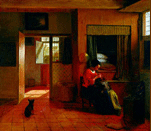










27.
The Dialogue as Structure and Strategy
in Court and Convent Literature
Organizers:
Description:
We have organized our workshop in such a way as to maximize the dialogic quality of an in-depth discussion on how the Italian Tullia d’Aragona (in 1547) and the Spaniard María de San José Salazar (in 1585) addressed issues of epistemology and power through their literary dialogues. D’Aragona (15150-1556) was known as an intellectual courtesan in works by prominent authors and celebrated for her own prose and poetry. María de San José (1548-1603) was a leading follower of Saint Teresa of Avila’s in the founding of the reformed—Discalced—Carmelites and her earliest biographer. Saint Teresa referred to María as her letrera, her scholar.
The focus for our exploration will be short but exemplary excerpts from works by these two proto-feminist sixteenth-century authors who adopt, adapt, and subvert the Neo-platonic dialogue. Participants will converse on points suggested by their reading of the selected pages. Mikhail Bakhtin theorized that dialogic forms offer: “. . . the corrective of laughter and criticism to all existing straightforward genres, languages, styles, voices; to force men to experience beneath these categories a different and contradictory reality…”(The Dialogic Imagination, 59). Bakhtin provides a starting point to our inquiry; the wit and wisdom of assertions by the two authors in question, however, will allow us to illustrate and adapt his significant critical pointers to our own purposes. Consider: (1) “Socrates adopted a learning stance, whereas you are imparting lessons.” (“Tullia” to Benedetto Varchi in d’Aragona’s The Dilaogue on the Infinity of Love). (2) “Now drop all these expressions of humility,” said Justa [to an older nun, Atanasia]; I know perfectly well what you are” (in San José Salazar’s Book for the Hour of Recreation).
Questions to pose to these texts might include: What are the ways in which the dialogic form itself, encompassing a polyphony of voices and a multiplicity of points of view, is more open and inclusive than other genres? How is it particularly suited to the representation of the experience of women and other “subaltern” groups? If the group is interested we may even consider the pedagogical/curricular potential of these particular dialogues for survey courses and other electives in the humanities.
Format:
Short 10–minute introduction to the session:
Participants will introduce themselves, their work, and their interest in
the workshop. We’ll ask each member of the group for a single question/comment
they hope will be addressed.
Two 30-minute sections of dialogue/conversation:
1. Divide into two groups in which one discusses the dialogue
which takes place in the atmosphere of the court, and the other, the dialogue
whose setting is the convent.
2. Divide each group in half and create two new groups composed of half and
half (half of the court group and half of the convent group).
Finally, a 20-minute wrap-up: we will go around the room to highlight some of the most provocative insights and, where appropriate, to refer back to initial questions/comments in the light of the hour of dialogue/discussion. We hope there will also be time to share thoughts on potential pedagogical and scholarly applications.
Some further questions the workshop might address:
|
|
|
||||||
|
|
 |
 |
|
||||
 |
|
 |
|
||||
|
|
|
||||||
|
|
|
||||||
 |
|
||||||
|
|
|
||||||
| |
|
||||||
 |
|
||||||
 |
|
||||||
 |
|
||||||
 |
|
||||||
|
|
|
||||||
|
|
 |
|
|
||||
 |
|
||||||
|
|
|
|
|
|
|
|
|